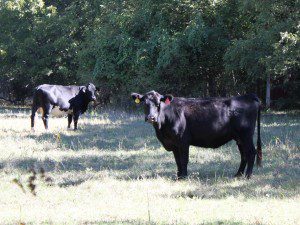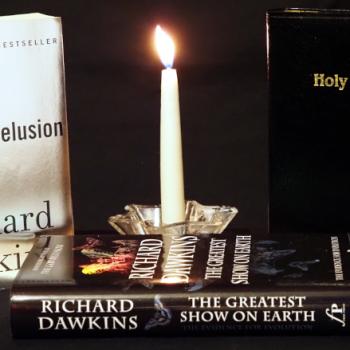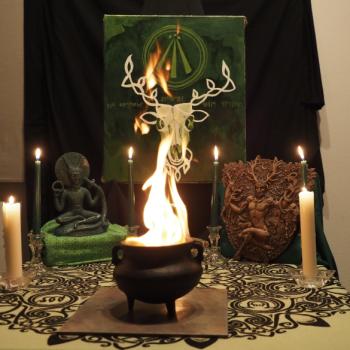I’m out of the country on a 12-day trip that’s part vacation and part pilgrimage. Yes, you’ll hear all about it when I get back. Until then, enjoy this update of an essay I wrote in 2011.
We are born alive – and hungry.
For a short time we are sustained by our mother’s milk. It is given freely and lovingly (in most cases, anyway), but that gift is possible only because our mothers consume other life.
Eventually the maternal intermediary is removed and we begin a life-long process of consuming things that were alive only a short time before we eat them. This is what every animal on the Earth does. Some eat plants, some eat other animals, some eat both. Life feeds on life.
 All life is sacred. All of Nature is sacred. But sacred or not, life feeds on life.
All life is sacred. All of Nature is sacred. But sacred or not, life feeds on life.
What is your relationship with food? What is your relationship with the living things that die so you can continue to live? Is it a conscious relationship? Is it an honest relationship? Is it in line with your values?
I see three general relationships people have with food.
A Mindless Relationship
The most common relationship people have with food is a mindless one. We see food and we eat it. If we like it we eat more. We give little thought to where it came from and even less to what it was before it was food.
This is not entirely a moral failure. Food has been scarce for most creatures for most of the time for most of the existence of life on Earth and it is still scarce for many people. We have evolved with instincts that tell us to eat as much as we can when food is available because it may be a long time before we can eat again.
As with any mindless action, mindless eating has negative repercussions. Survival instincts developed to deal with scarcity are creating health problems in a society where food is abundant. An emphasis on “cheap” and “fast” has led to factory farming and factory food production with all the nutritional and sustainability problems they present. Fruits and vegetables are genetically modified and chemically treated because most of us will mindlessly buy big, pretty, uniform produce with no consideration for nutrition or even for taste.
Can we become mindful about what we eat, where it comes from, and what it was before it was food?
A Hierarchical Relationship
We’re all familiar with the food chain: little animals eat plants, big animals eat little animals, fast and strong animals eat big animals. Humans are at the top… except when we’re not, such as when we swim in the ocean or hike in grizzly bear country.
In a hierarchical relationship, we do consider what something was before it was food, but we draw a clear line at some point in the hierarchy. Things below the line are just food – we eat them because we can. Things above the line are seen differently – they’re too close to us, so we don’t feel right about eating them.
Some of us draw the line at animals: plants are food, animals aren’t. Others draw the line at mammals: fish and chicken are food, cows and pigs aren’t. Our language reflects our uneasiness about eating our closer relatives: we don’t eat “cow” and “pig” – we eat “beef” and “pork.” Even the carnivores among us look down on people who eat horses and dogs and monkeys… or at the least, we employ considerable intellectual gymnastics to rationalize the practice in terms of cultural sensitivity.
Can we examine our food hierarchies? Can we see that even things below our “this is food and that is a relative” line are (or were) alive? Can we remember John Barleycorn Must Die?
A Sacramental Relationship
Examining what we eat can be difficult. It can be more work to find out where our food comes from. It can be more expensive to buy food that is produced ethically and sustainably. And it can be troubling to consider that what is keeping us alive – and what is providing us with the pleasure of eating – was itself alive only a short time ago.
Feelings of guilt are not helpful. We have to eat – as does every other animal in the world. Guilt just encourages us to not think about it – to engage in mindless eating. Our eating will not be ethical if it is not mindful.
Every living thing we eat is a sacrifice. Is that sacrifice given freely? I know there are traditions among some indigenous peoples that their shamans will speak with the spirit of an animal and ask for a sacrifice to sustain the tribe. An animal will then be taken in the hunt. Far be it from me to tell a shaman what he did or didn’t do on his journey. Perhaps animals are more sympathetic to people who live close to the land. But the survival instinct is strong in every animal – including humans.
Whether it is given freely or not, every living thing we eat is a sacrifice. Its life is given – or taken – to sustain us.
Can we acknowledge that sacrifice? Can we give thanks, not just to the Earth Mother but also to the plants and animals that keep us alive? Can we honor their sacrifice by supporting ethical agriculture that insures the continuity of the species that die to feed us?
The poet Wendell Berry said this:
We cannot live harmlessly or strictly at our own expense; we depend upon other creatures and survive by their death. To live, we must daily break the body and shed the blood of creation. The point is, when we do this knowingly, lovingly, skillfully, reverently, it is a sacrament; when we do it ignorantly, greedily, clumsily, destructively, it is a desecration.
May all our eating be sacramental eating.

















